Comprehensive Risk Management Report: Citi Store Cafe Business
VerifiedAdded on 2020/05/04
|28
|6237
|68
Report
AI Summary
This report provides a comprehensive analysis of risk management strategies for a new cafe opening within a Citi store. It begins with an introduction to risk management principles and its importance for business continuity. The report then proceeds to Task 1, focusing on the effectiveness of risk management and its legislative context, particularly referencing the AS/NZS ISO 31000:2009 standard. Task 2 covers the scope of risk management, identifying both internal and external stakeholders and their roles. Task 3 involves a PEST and SWOT analysis to understand the cafe's environment, followed by the definition of objectives and the importance of management support. The core of the report, Task 4, focuses on risk assessment, including identification, brainstorming sessions, and a detailed list of potential risks. Task 5 delves into analysis and evaluation using likelihood and consequence matrices to assess risks and develop mitigation strategies. Finally, Task 6 outlines suitable risk treatment methods, action plans, a risk register, and stakeholder communication strategies, concluding with a discussion of implementation and monitoring phases. The report underscores the importance of proactive risk management for the success and sustainability of the cafe business.
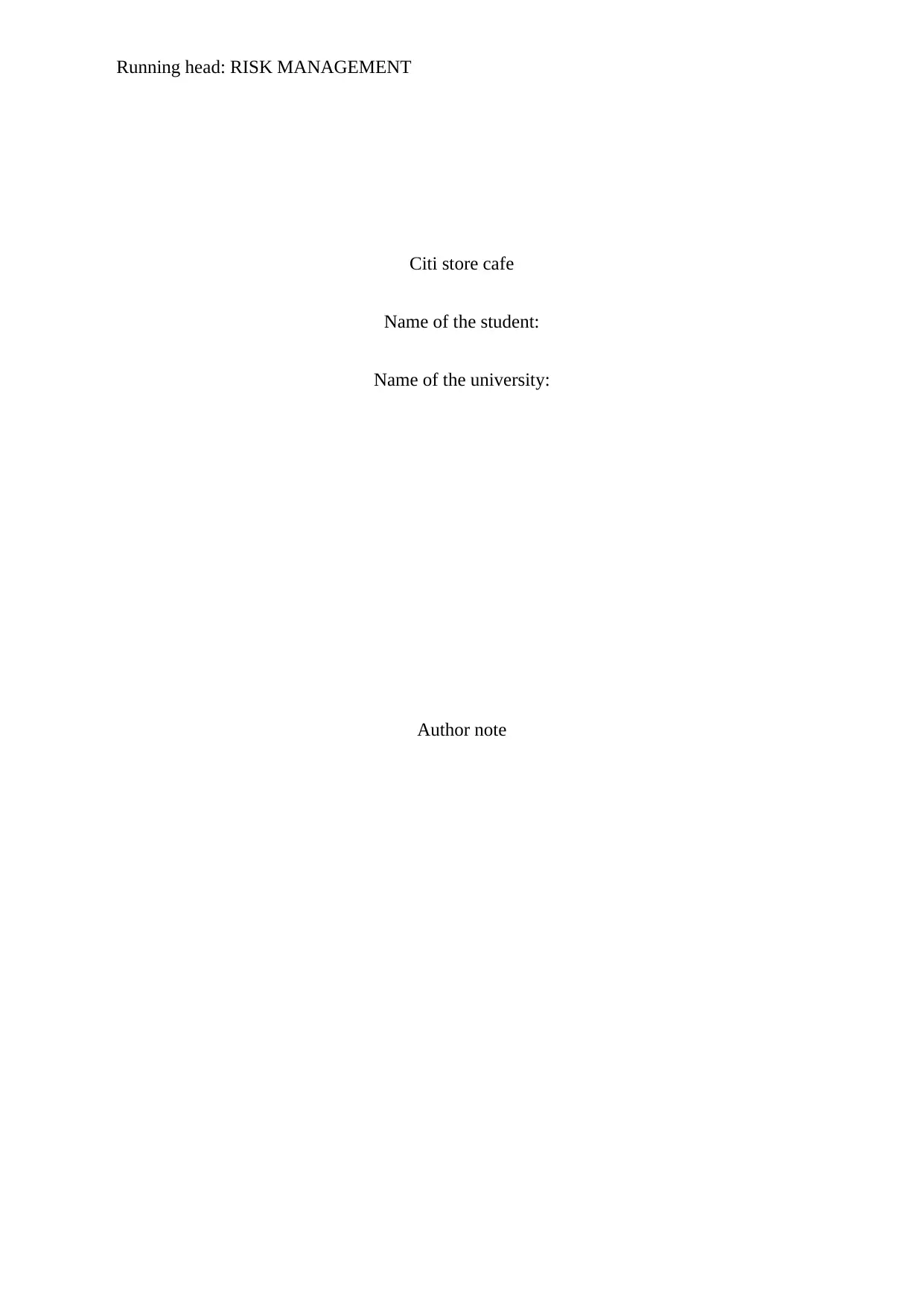
Running head: RISK MANAGEMENT
Citi store cafe
Name of the student:
Name of the university:
Author note
Citi store cafe
Name of the student:
Name of the university:
Author note
Paraphrase This Document
Need a fresh take? Get an instant paraphrase of this document with our AI Paraphraser
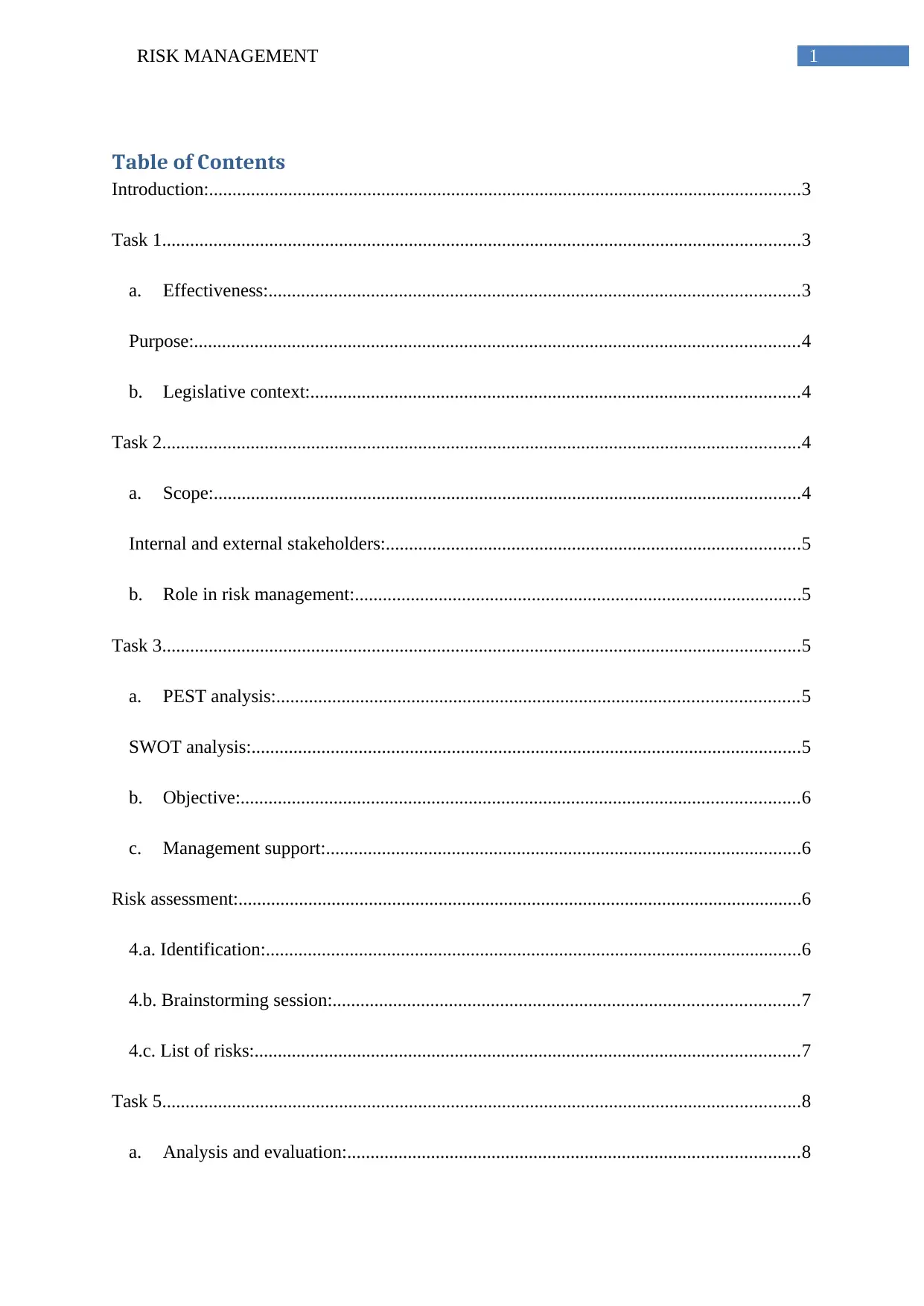
1RISK MANAGEMENT
Table of Contents
Introduction:...............................................................................................................................3
Task 1.........................................................................................................................................3
a. Effectiveness:..................................................................................................................3
Purpose:..................................................................................................................................4
b. Legislative context:.........................................................................................................4
Task 2.........................................................................................................................................4
a. Scope:..............................................................................................................................4
Internal and external stakeholders:.........................................................................................5
b. Role in risk management:................................................................................................5
Task 3.........................................................................................................................................5
a. PEST analysis:................................................................................................................5
SWOT analysis:......................................................................................................................5
b. Objective:........................................................................................................................6
c. Management support:......................................................................................................6
Risk assessment:.........................................................................................................................6
4.a. Identification:...................................................................................................................6
4.b. Brainstorming session:....................................................................................................7
4.c. List of risks:.....................................................................................................................7
Task 5.........................................................................................................................................8
a. Analysis and evaluation:.................................................................................................8
Table of Contents
Introduction:...............................................................................................................................3
Task 1.........................................................................................................................................3
a. Effectiveness:..................................................................................................................3
Purpose:..................................................................................................................................4
b. Legislative context:.........................................................................................................4
Task 2.........................................................................................................................................4
a. Scope:..............................................................................................................................4
Internal and external stakeholders:.........................................................................................5
b. Role in risk management:................................................................................................5
Task 3.........................................................................................................................................5
a. PEST analysis:................................................................................................................5
SWOT analysis:......................................................................................................................5
b. Objective:........................................................................................................................6
c. Management support:......................................................................................................6
Risk assessment:.........................................................................................................................6
4.a. Identification:...................................................................................................................6
4.b. Brainstorming session:....................................................................................................7
4.c. List of risks:.....................................................................................................................7
Task 5.........................................................................................................................................8
a. Analysis and evaluation:.................................................................................................8
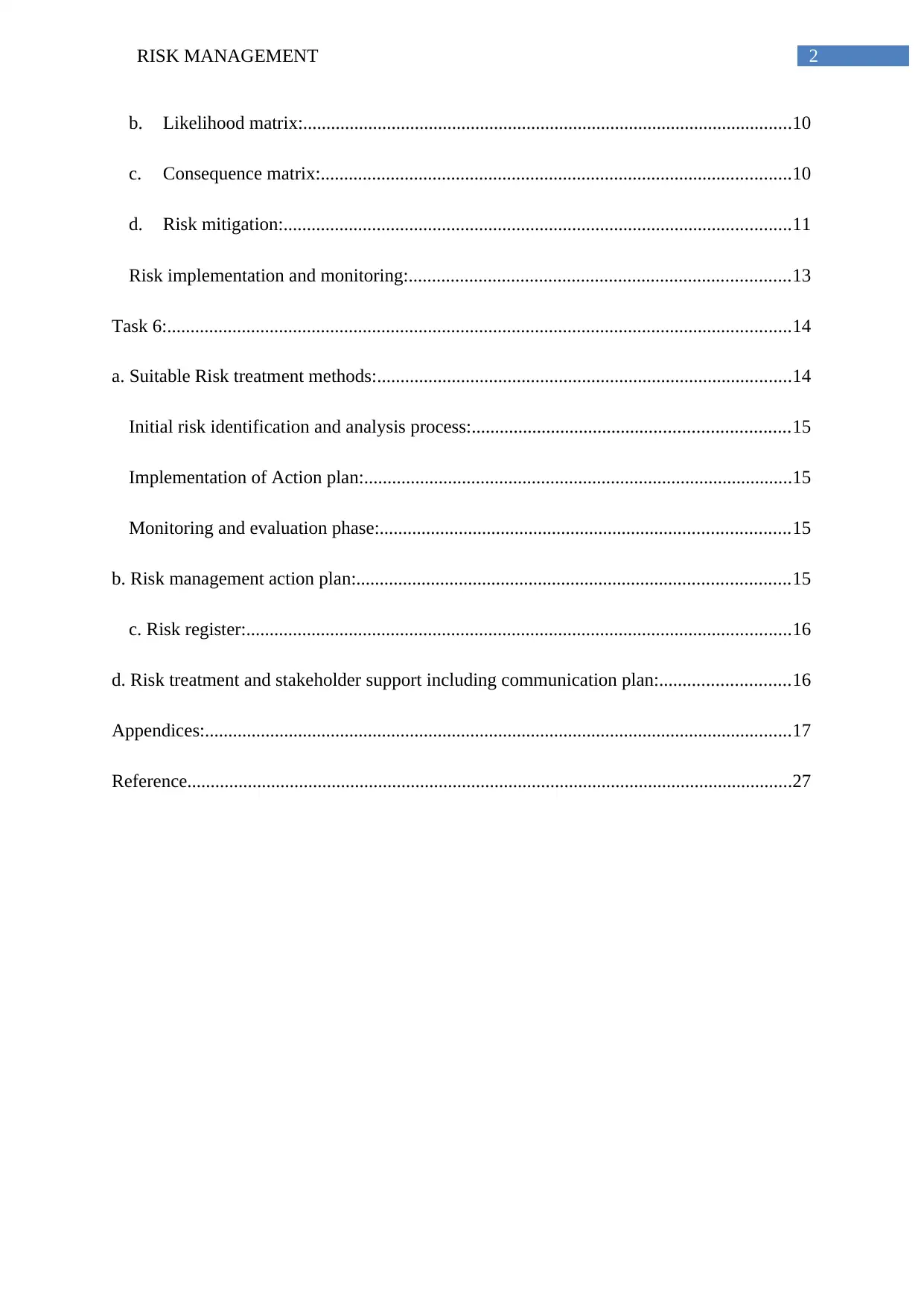
2RISK MANAGEMENT
b. Likelihood matrix:.........................................................................................................10
c. Consequence matrix:.....................................................................................................10
d. Risk mitigation:.............................................................................................................11
Risk implementation and monitoring:..................................................................................13
Task 6:......................................................................................................................................14
a. Suitable Risk treatment methods:.........................................................................................14
Initial risk identification and analysis process:....................................................................15
Implementation of Action plan:............................................................................................15
Monitoring and evaluation phase:........................................................................................15
b. Risk management action plan:.............................................................................................15
c. Risk register:.....................................................................................................................16
d. Risk treatment and stakeholder support including communication plan:............................16
Appendices:..............................................................................................................................17
Reference..................................................................................................................................27
b. Likelihood matrix:.........................................................................................................10
c. Consequence matrix:.....................................................................................................10
d. Risk mitigation:.............................................................................................................11
Risk implementation and monitoring:..................................................................................13
Task 6:......................................................................................................................................14
a. Suitable Risk treatment methods:.........................................................................................14
Initial risk identification and analysis process:....................................................................15
Implementation of Action plan:............................................................................................15
Monitoring and evaluation phase:........................................................................................15
b. Risk management action plan:.............................................................................................15
c. Risk register:.....................................................................................................................16
d. Risk treatment and stakeholder support including communication plan:............................16
Appendices:..............................................................................................................................17
Reference..................................................................................................................................27
⊘ This is a preview!⊘
Do you want full access?
Subscribe today to unlock all pages.

Trusted by 1+ million students worldwide
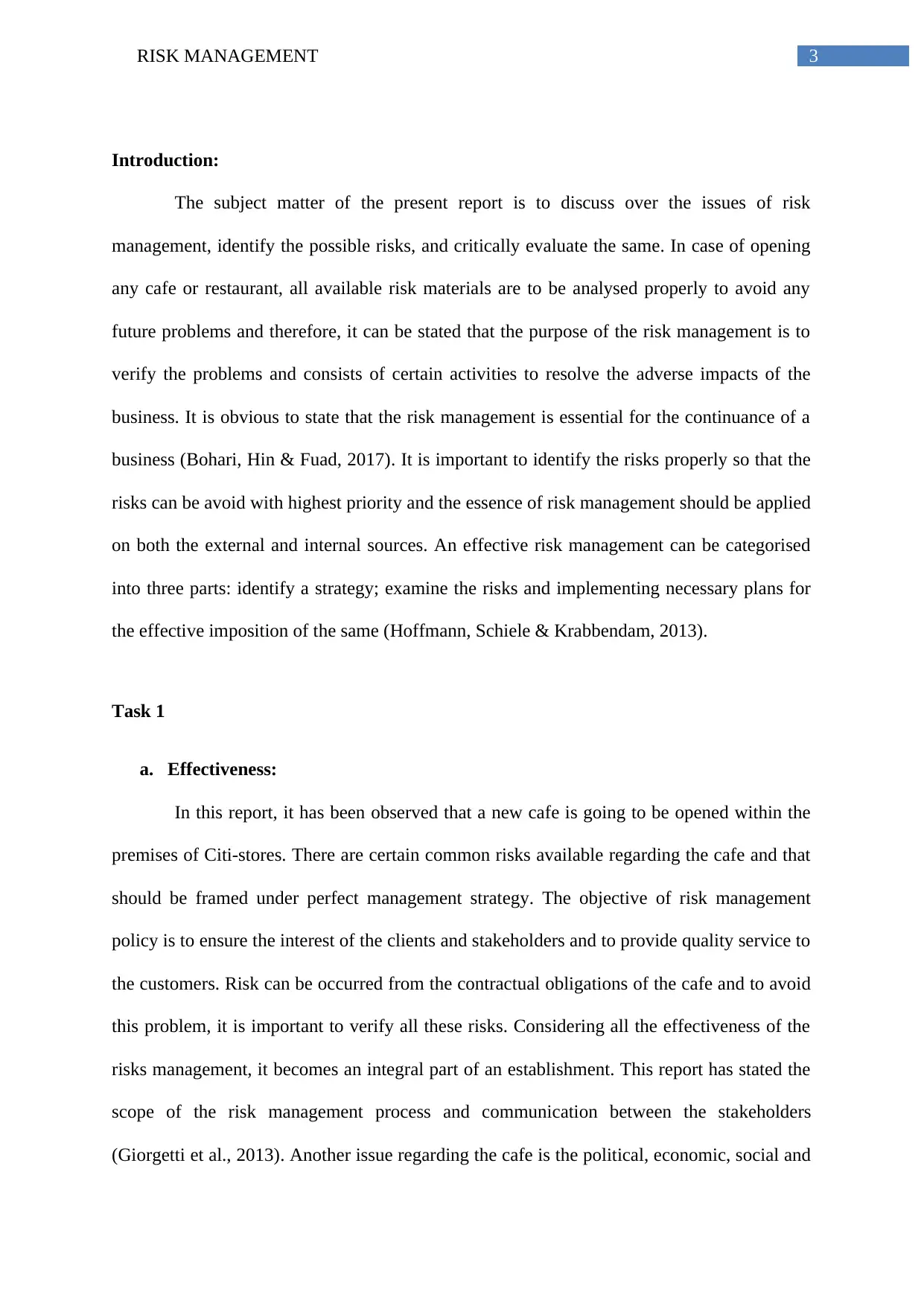
3RISK MANAGEMENT
Introduction:
The subject matter of the present report is to discuss over the issues of risk
management, identify the possible risks, and critically evaluate the same. In case of opening
any cafe or restaurant, all available risk materials are to be analysed properly to avoid any
future problems and therefore, it can be stated that the purpose of the risk management is to
verify the problems and consists of certain activities to resolve the adverse impacts of the
business. It is obvious to state that the risk management is essential for the continuance of a
business (Bohari, Hin & Fuad, 2017). It is important to identify the risks properly so that the
risks can be avoid with highest priority and the essence of risk management should be applied
on both the external and internal sources. An effective risk management can be categorised
into three parts: identify a strategy; examine the risks and implementing necessary plans for
the effective imposition of the same (Hoffmann, Schiele & Krabbendam, 2013).
Task 1
a. Effectiveness:
In this report, it has been observed that a new cafe is going to be opened within the
premises of Citi-stores. There are certain common risks available regarding the cafe and that
should be framed under perfect management strategy. The objective of risk management
policy is to ensure the interest of the clients and stakeholders and to provide quality service to
the customers. Risk can be occurred from the contractual obligations of the cafe and to avoid
this problem, it is important to verify all these risks. Considering all the effectiveness of the
risks management, it becomes an integral part of an establishment. This report has stated the
scope of the risk management process and communication between the stakeholders
(Giorgetti et al., 2013). Another issue regarding the cafe is the political, economic, social and
Introduction:
The subject matter of the present report is to discuss over the issues of risk
management, identify the possible risks, and critically evaluate the same. In case of opening
any cafe or restaurant, all available risk materials are to be analysed properly to avoid any
future problems and therefore, it can be stated that the purpose of the risk management is to
verify the problems and consists of certain activities to resolve the adverse impacts of the
business. It is obvious to state that the risk management is essential for the continuance of a
business (Bohari, Hin & Fuad, 2017). It is important to identify the risks properly so that the
risks can be avoid with highest priority and the essence of risk management should be applied
on both the external and internal sources. An effective risk management can be categorised
into three parts: identify a strategy; examine the risks and implementing necessary plans for
the effective imposition of the same (Hoffmann, Schiele & Krabbendam, 2013).
Task 1
a. Effectiveness:
In this report, it has been observed that a new cafe is going to be opened within the
premises of Citi-stores. There are certain common risks available regarding the cafe and that
should be framed under perfect management strategy. The objective of risk management
policy is to ensure the interest of the clients and stakeholders and to provide quality service to
the customers. Risk can be occurred from the contractual obligations of the cafe and to avoid
this problem, it is important to verify all these risks. Considering all the effectiveness of the
risks management, it becomes an integral part of an establishment. This report has stated the
scope of the risk management process and communication between the stakeholders
(Giorgetti et al., 2013). Another issue regarding the cafe is the political, economic, social and
Paraphrase This Document
Need a fresh take? Get an instant paraphrase of this document with our AI Paraphraser
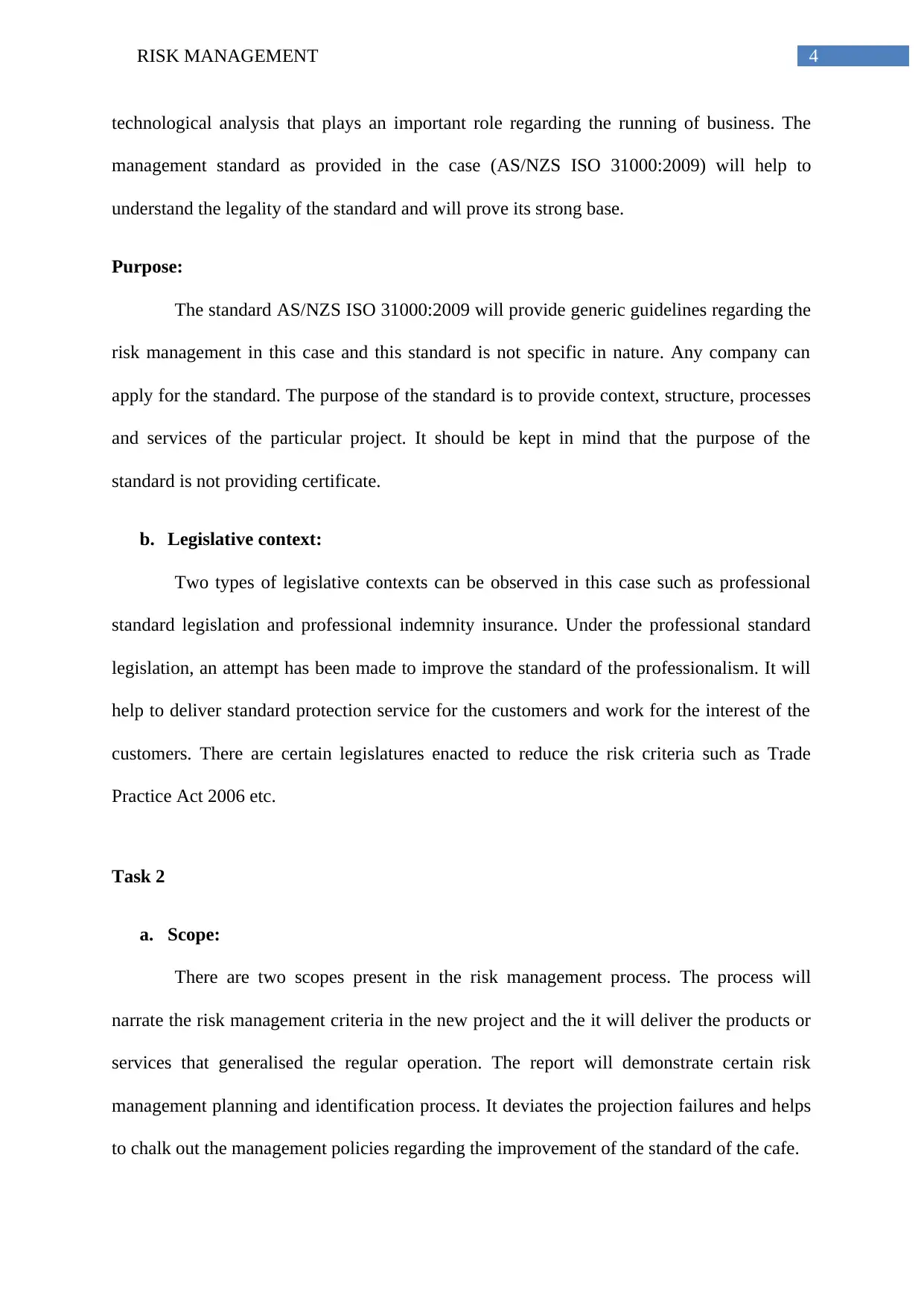
4RISK MANAGEMENT
technological analysis that plays an important role regarding the running of business. The
management standard as provided in the case (AS/NZS ISO 31000:2009) will help to
understand the legality of the standard and will prove its strong base.
Purpose:
The standard AS/NZS ISO 31000:2009 will provide generic guidelines regarding the
risk management in this case and this standard is not specific in nature. Any company can
apply for the standard. The purpose of the standard is to provide context, structure, processes
and services of the particular project. It should be kept in mind that the purpose of the
standard is not providing certificate.
b. Legislative context:
Two types of legislative contexts can be observed in this case such as professional
standard legislation and professional indemnity insurance. Under the professional standard
legislation, an attempt has been made to improve the standard of the professionalism. It will
help to deliver standard protection service for the customers and work for the interest of the
customers. There are certain legislatures enacted to reduce the risk criteria such as Trade
Practice Act 2006 etc.
Task 2
a. Scope:
There are two scopes present in the risk management process. The process will
narrate the risk management criteria in the new project and the it will deliver the products or
services that generalised the regular operation. The report will demonstrate certain risk
management planning and identification process. It deviates the projection failures and helps
to chalk out the management policies regarding the improvement of the standard of the cafe.
technological analysis that plays an important role regarding the running of business. The
management standard as provided in the case (AS/NZS ISO 31000:2009) will help to
understand the legality of the standard and will prove its strong base.
Purpose:
The standard AS/NZS ISO 31000:2009 will provide generic guidelines regarding the
risk management in this case and this standard is not specific in nature. Any company can
apply for the standard. The purpose of the standard is to provide context, structure, processes
and services of the particular project. It should be kept in mind that the purpose of the
standard is not providing certificate.
b. Legislative context:
Two types of legislative contexts can be observed in this case such as professional
standard legislation and professional indemnity insurance. Under the professional standard
legislation, an attempt has been made to improve the standard of the professionalism. It will
help to deliver standard protection service for the customers and work for the interest of the
customers. There are certain legislatures enacted to reduce the risk criteria such as Trade
Practice Act 2006 etc.
Task 2
a. Scope:
There are two scopes present in the risk management process. The process will
narrate the risk management criteria in the new project and the it will deliver the products or
services that generalised the regular operation. The report will demonstrate certain risk
management planning and identification process. It deviates the projection failures and helps
to chalk out the management policies regarding the improvement of the standard of the cafe.
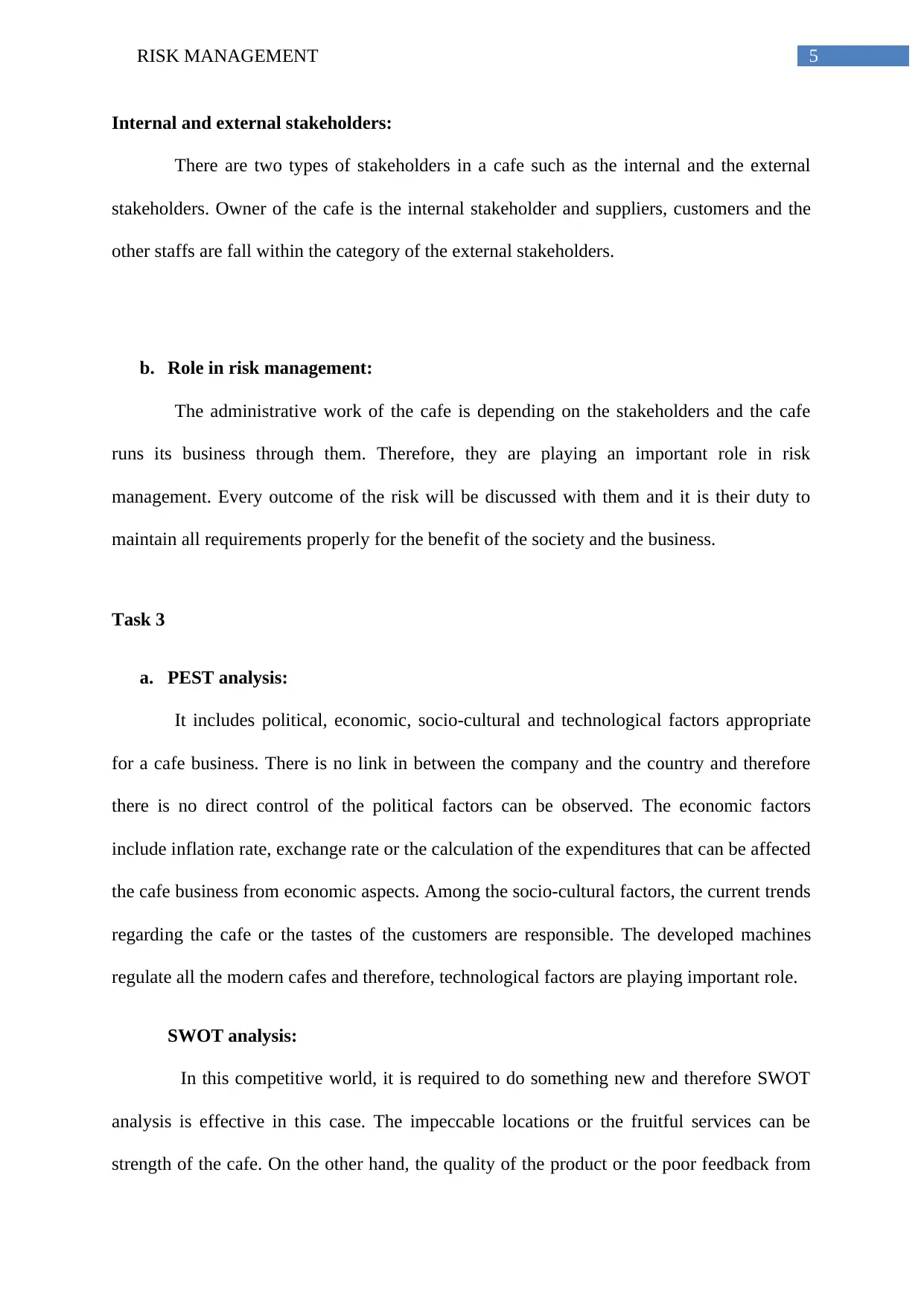
5RISK MANAGEMENT
Internal and external stakeholders:
There are two types of stakeholders in a cafe such as the internal and the external
stakeholders. Owner of the cafe is the internal stakeholder and suppliers, customers and the
other staffs are fall within the category of the external stakeholders.
b. Role in risk management:
The administrative work of the cafe is depending on the stakeholders and the cafe
runs its business through them. Therefore, they are playing an important role in risk
management. Every outcome of the risk will be discussed with them and it is their duty to
maintain all requirements properly for the benefit of the society and the business.
Task 3
a. PEST analysis:
It includes political, economic, socio-cultural and technological factors appropriate
for a cafe business. There is no link in between the company and the country and therefore
there is no direct control of the political factors can be observed. The economic factors
include inflation rate, exchange rate or the calculation of the expenditures that can be affected
the cafe business from economic aspects. Among the socio-cultural factors, the current trends
regarding the cafe or the tastes of the customers are responsible. The developed machines
regulate all the modern cafes and therefore, technological factors are playing important role.
SWOT analysis:
In this competitive world, it is required to do something new and therefore SWOT
analysis is effective in this case. The impeccable locations or the fruitful services can be
strength of the cafe. On the other hand, the quality of the product or the poor feedback from
Internal and external stakeholders:
There are two types of stakeholders in a cafe such as the internal and the external
stakeholders. Owner of the cafe is the internal stakeholder and suppliers, customers and the
other staffs are fall within the category of the external stakeholders.
b. Role in risk management:
The administrative work of the cafe is depending on the stakeholders and the cafe
runs its business through them. Therefore, they are playing an important role in risk
management. Every outcome of the risk will be discussed with them and it is their duty to
maintain all requirements properly for the benefit of the society and the business.
Task 3
a. PEST analysis:
It includes political, economic, socio-cultural and technological factors appropriate
for a cafe business. There is no link in between the company and the country and therefore
there is no direct control of the political factors can be observed. The economic factors
include inflation rate, exchange rate or the calculation of the expenditures that can be affected
the cafe business from economic aspects. Among the socio-cultural factors, the current trends
regarding the cafe or the tastes of the customers are responsible. The developed machines
regulate all the modern cafes and therefore, technological factors are playing important role.
SWOT analysis:
In this competitive world, it is required to do something new and therefore SWOT
analysis is effective in this case. The impeccable locations or the fruitful services can be
strength of the cafe. On the other hand, the quality of the product or the poor feedback from
⊘ This is a preview!⊘
Do you want full access?
Subscribe today to unlock all pages.

Trusted by 1+ million students worldwide
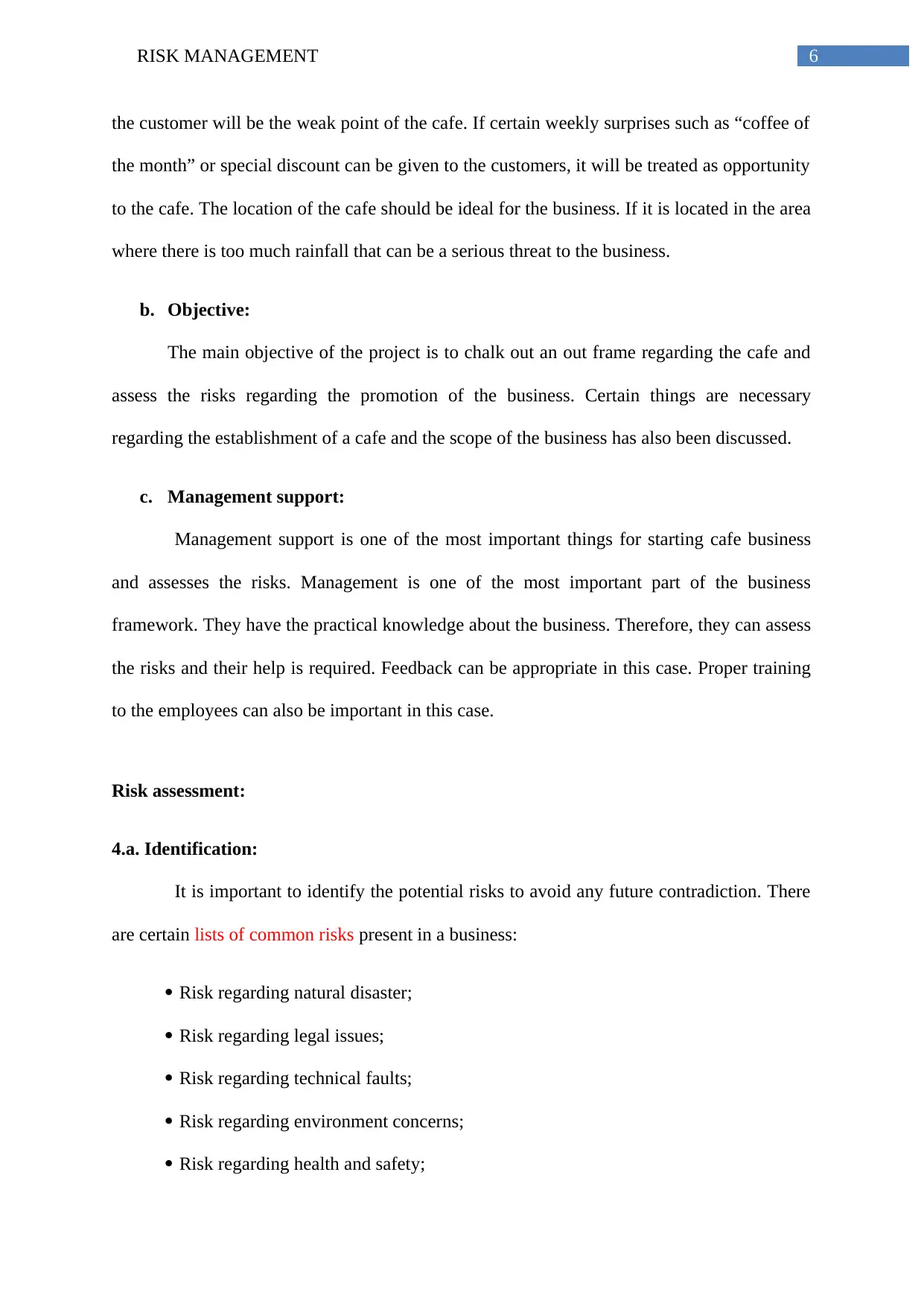
6RISK MANAGEMENT
the customer will be the weak point of the cafe. If certain weekly surprises such as “coffee of
the month” or special discount can be given to the customers, it will be treated as opportunity
to the cafe. The location of the cafe should be ideal for the business. If it is located in the area
where there is too much rainfall that can be a serious threat to the business.
b. Objective:
The main objective of the project is to chalk out an out frame regarding the cafe and
assess the risks regarding the promotion of the business. Certain things are necessary
regarding the establishment of a cafe and the scope of the business has also been discussed.
c. Management support:
Management support is one of the most important things for starting cafe business
and assesses the risks. Management is one of the most important part of the business
framework. They have the practical knowledge about the business. Therefore, they can assess
the risks and their help is required. Feedback can be appropriate in this case. Proper training
to the employees can also be important in this case.
Risk assessment:
4.a. Identification:
It is important to identify the potential risks to avoid any future contradiction. There
are certain lists of common risks present in a business:
Risk regarding natural disaster;
Risk regarding legal issues;
Risk regarding technical faults;
Risk regarding environment concerns;
Risk regarding health and safety;
the customer will be the weak point of the cafe. If certain weekly surprises such as “coffee of
the month” or special discount can be given to the customers, it will be treated as opportunity
to the cafe. The location of the cafe should be ideal for the business. If it is located in the area
where there is too much rainfall that can be a serious threat to the business.
b. Objective:
The main objective of the project is to chalk out an out frame regarding the cafe and
assess the risks regarding the promotion of the business. Certain things are necessary
regarding the establishment of a cafe and the scope of the business has also been discussed.
c. Management support:
Management support is one of the most important things for starting cafe business
and assesses the risks. Management is one of the most important part of the business
framework. They have the practical knowledge about the business. Therefore, they can assess
the risks and their help is required. Feedback can be appropriate in this case. Proper training
to the employees can also be important in this case.
Risk assessment:
4.a. Identification:
It is important to identify the potential risks to avoid any future contradiction. There
are certain lists of common risks present in a business:
Risk regarding natural disaster;
Risk regarding legal issues;
Risk regarding technical faults;
Risk regarding environment concerns;
Risk regarding health and safety;
Paraphrase This Document
Need a fresh take? Get an instant paraphrase of this document with our AI Paraphraser
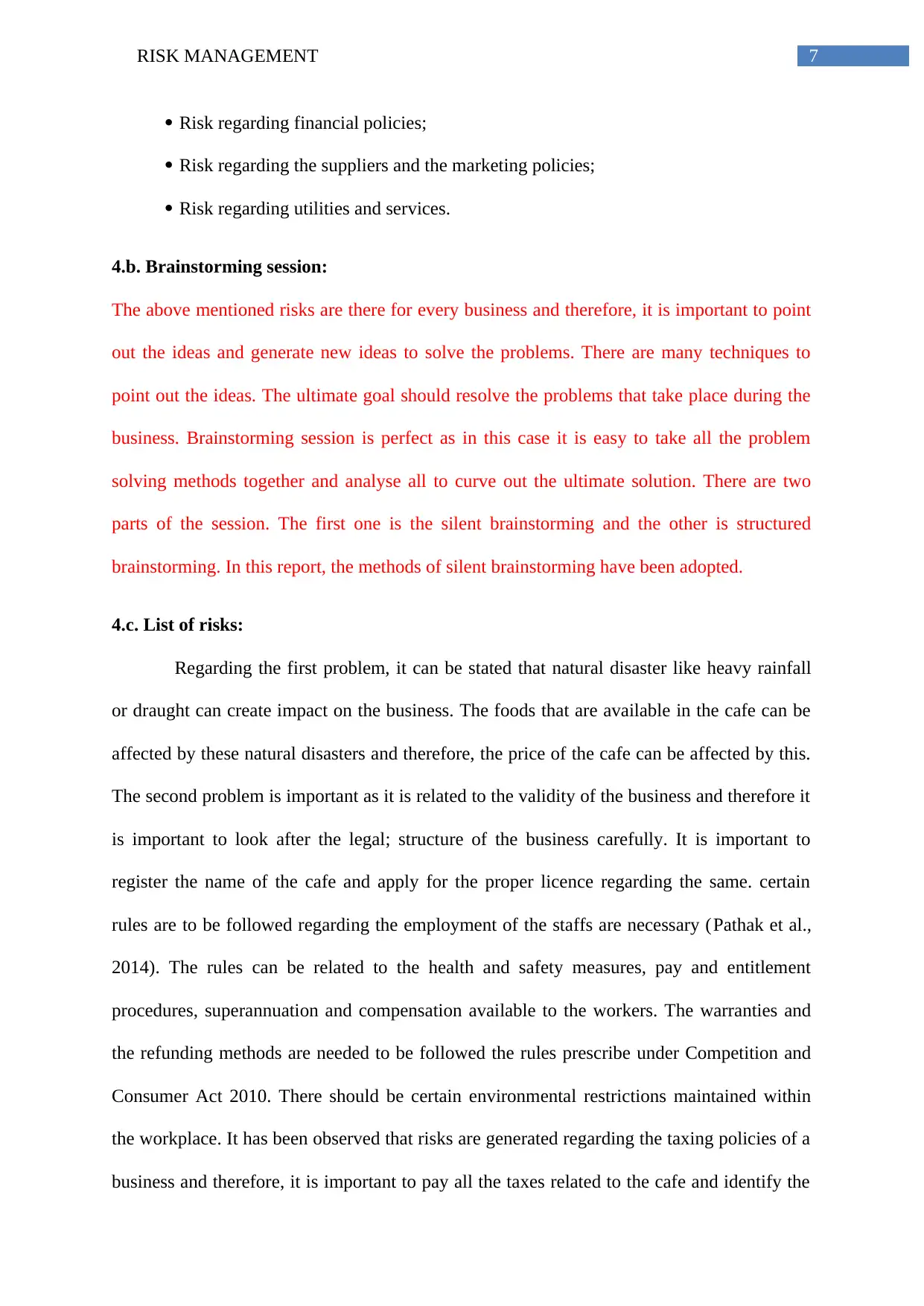
7RISK MANAGEMENT
Risk regarding financial policies;
Risk regarding the suppliers and the marketing policies;
Risk regarding utilities and services.
4.b. Brainstorming session:
The above mentioned risks are there for every business and therefore, it is important to point
out the ideas and generate new ideas to solve the problems. There are many techniques to
point out the ideas. The ultimate goal should resolve the problems that take place during the
business. Brainstorming session is perfect as in this case it is easy to take all the problem
solving methods together and analyse all to curve out the ultimate solution. There are two
parts of the session. The first one is the silent brainstorming and the other is structured
brainstorming. In this report, the methods of silent brainstorming have been adopted.
4.c. List of risks:
Regarding the first problem, it can be stated that natural disaster like heavy rainfall
or draught can create impact on the business. The foods that are available in the cafe can be
affected by these natural disasters and therefore, the price of the cafe can be affected by this.
The second problem is important as it is related to the validity of the business and therefore it
is important to look after the legal; structure of the business carefully. It is important to
register the name of the cafe and apply for the proper licence regarding the same. certain
rules are to be followed regarding the employment of the staffs are necessary (Pathak et al.,
2014). The rules can be related to the health and safety measures, pay and entitlement
procedures, superannuation and compensation available to the workers. The warranties and
the refunding methods are needed to be followed the rules prescribe under Competition and
Consumer Act 2010. There should be certain environmental restrictions maintained within
the workplace. It has been observed that risks are generated regarding the taxing policies of a
business and therefore, it is important to pay all the taxes related to the cafe and identify the
Risk regarding financial policies;
Risk regarding the suppliers and the marketing policies;
Risk regarding utilities and services.
4.b. Brainstorming session:
The above mentioned risks are there for every business and therefore, it is important to point
out the ideas and generate new ideas to solve the problems. There are many techniques to
point out the ideas. The ultimate goal should resolve the problems that take place during the
business. Brainstorming session is perfect as in this case it is easy to take all the problem
solving methods together and analyse all to curve out the ultimate solution. There are two
parts of the session. The first one is the silent brainstorming and the other is structured
brainstorming. In this report, the methods of silent brainstorming have been adopted.
4.c. List of risks:
Regarding the first problem, it can be stated that natural disaster like heavy rainfall
or draught can create impact on the business. The foods that are available in the cafe can be
affected by these natural disasters and therefore, the price of the cafe can be affected by this.
The second problem is important as it is related to the validity of the business and therefore it
is important to look after the legal; structure of the business carefully. It is important to
register the name of the cafe and apply for the proper licence regarding the same. certain
rules are to be followed regarding the employment of the staffs are necessary (Pathak et al.,
2014). The rules can be related to the health and safety measures, pay and entitlement
procedures, superannuation and compensation available to the workers. The warranties and
the refunding methods are needed to be followed the rules prescribe under Competition and
Consumer Act 2010. There should be certain environmental restrictions maintained within
the workplace. It has been observed that risks are generated regarding the taxing policies of a
business and therefore, it is important to pay all the taxes related to the cafe and identify the
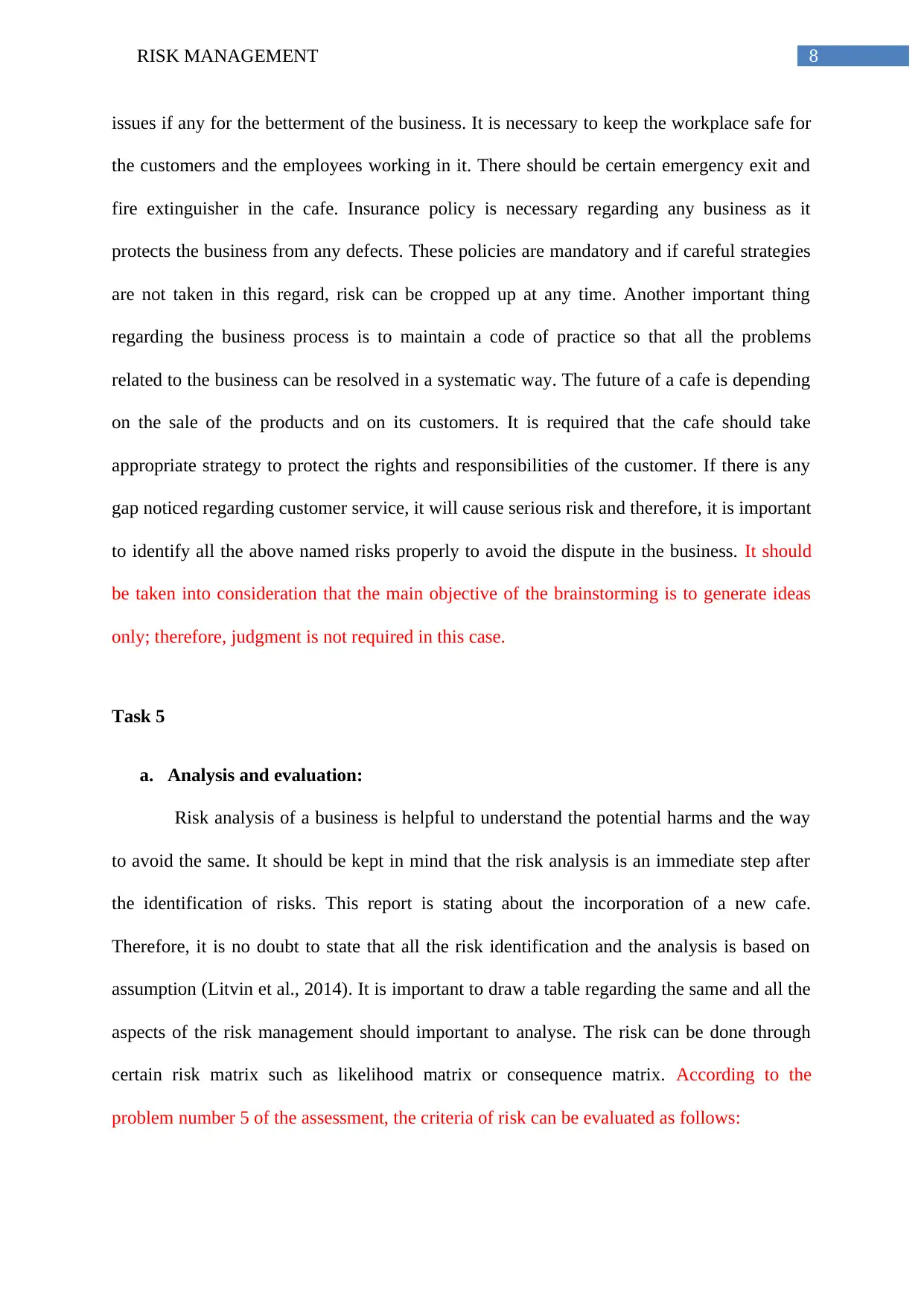
8RISK MANAGEMENT
issues if any for the betterment of the business. It is necessary to keep the workplace safe for
the customers and the employees working in it. There should be certain emergency exit and
fire extinguisher in the cafe. Insurance policy is necessary regarding any business as it
protects the business from any defects. These policies are mandatory and if careful strategies
are not taken in this regard, risk can be cropped up at any time. Another important thing
regarding the business process is to maintain a code of practice so that all the problems
related to the business can be resolved in a systematic way. The future of a cafe is depending
on the sale of the products and on its customers. It is required that the cafe should take
appropriate strategy to protect the rights and responsibilities of the customer. If there is any
gap noticed regarding customer service, it will cause serious risk and therefore, it is important
to identify all the above named risks properly to avoid the dispute in the business. It should
be taken into consideration that the main objective of the brainstorming is to generate ideas
only; therefore, judgment is not required in this case.
Task 5
a. Analysis and evaluation:
Risk analysis of a business is helpful to understand the potential harms and the way
to avoid the same. It should be kept in mind that the risk analysis is an immediate step after
the identification of risks. This report is stating about the incorporation of a new cafe.
Therefore, it is no doubt to state that all the risk identification and the analysis is based on
assumption (Litvin et al., 2014). It is important to draw a table regarding the same and all the
aspects of the risk management should important to analyse. The risk can be done through
certain risk matrix such as likelihood matrix or consequence matrix. According to the
problem number 5 of the assessment, the criteria of risk can be evaluated as follows:
issues if any for the betterment of the business. It is necessary to keep the workplace safe for
the customers and the employees working in it. There should be certain emergency exit and
fire extinguisher in the cafe. Insurance policy is necessary regarding any business as it
protects the business from any defects. These policies are mandatory and if careful strategies
are not taken in this regard, risk can be cropped up at any time. Another important thing
regarding the business process is to maintain a code of practice so that all the problems
related to the business can be resolved in a systematic way. The future of a cafe is depending
on the sale of the products and on its customers. It is required that the cafe should take
appropriate strategy to protect the rights and responsibilities of the customer. If there is any
gap noticed regarding customer service, it will cause serious risk and therefore, it is important
to identify all the above named risks properly to avoid the dispute in the business. It should
be taken into consideration that the main objective of the brainstorming is to generate ideas
only; therefore, judgment is not required in this case.
Task 5
a. Analysis and evaluation:
Risk analysis of a business is helpful to understand the potential harms and the way
to avoid the same. It should be kept in mind that the risk analysis is an immediate step after
the identification of risks. This report is stating about the incorporation of a new cafe.
Therefore, it is no doubt to state that all the risk identification and the analysis is based on
assumption (Litvin et al., 2014). It is important to draw a table regarding the same and all the
aspects of the risk management should important to analyse. The risk can be done through
certain risk matrix such as likelihood matrix or consequence matrix. According to the
problem number 5 of the assessment, the criteria of risk can be evaluated as follows:
⊘ This is a preview!⊘
Do you want full access?
Subscribe today to unlock all pages.

Trusted by 1+ million students worldwide
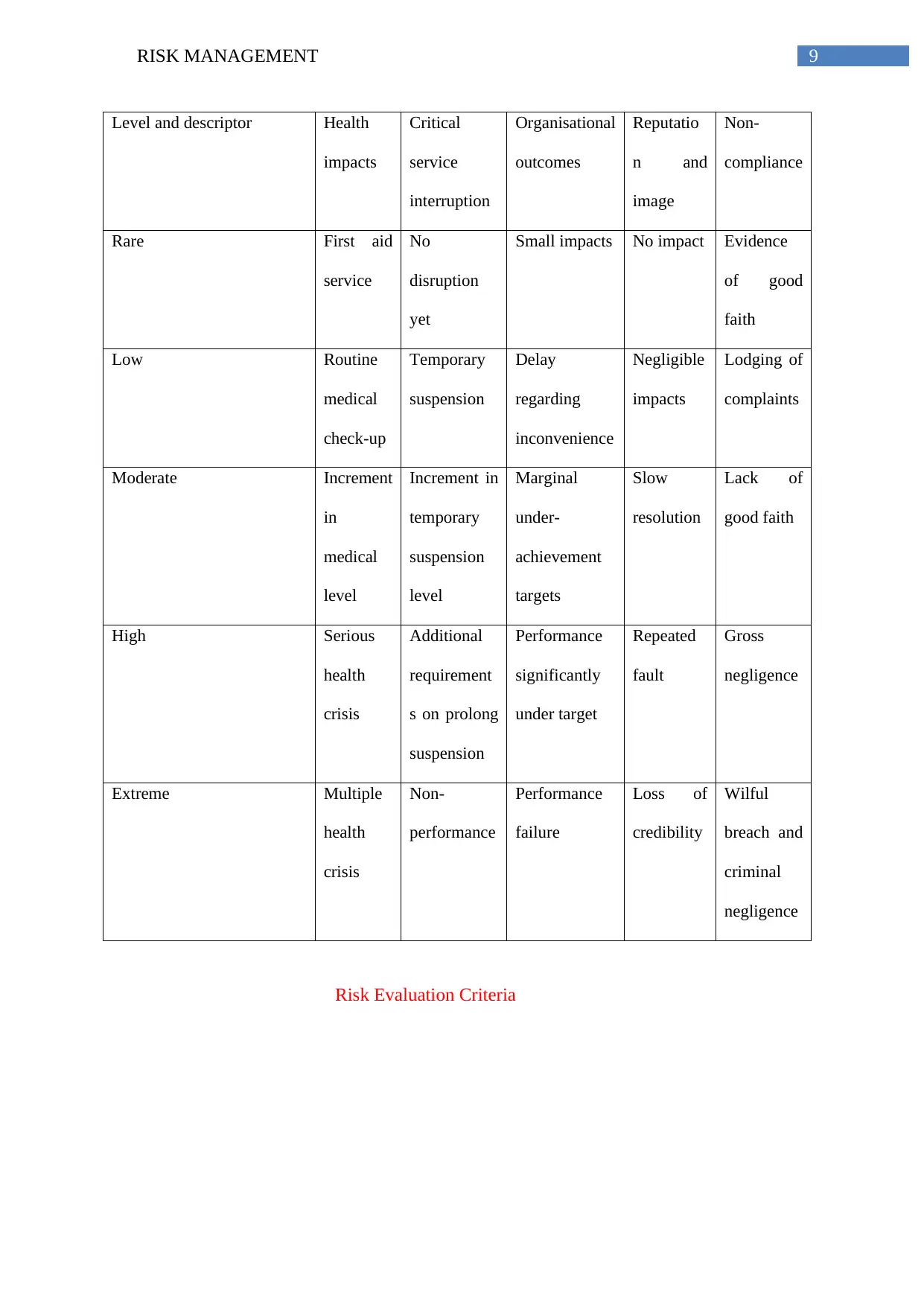
9RISK MANAGEMENT
Level and descriptor Health
impacts
Critical
service
interruption
Organisational
outcomes
Reputatio
n and
image
Non-
compliance
Rare First aid
service
No
disruption
yet
Small impacts No impact Evidence
of good
faith
Low Routine
medical
check-up
Temporary
suspension
Delay
regarding
inconvenience
Negligible
impacts
Lodging of
complaints
Moderate Increment
in
medical
level
Increment in
temporary
suspension
level
Marginal
under-
achievement
targets
Slow
resolution
Lack of
good faith
High Serious
health
crisis
Additional
requirement
s on prolong
suspension
Performance
significantly
under target
Repeated
fault
Gross
negligence
Extreme Multiple
health
crisis
Non-
performance
Performance
failure
Loss of
credibility
Wilful
breach and
criminal
negligence
Risk Evaluation Criteria
Level and descriptor Health
impacts
Critical
service
interruption
Organisational
outcomes
Reputatio
n and
image
Non-
compliance
Rare First aid
service
No
disruption
yet
Small impacts No impact Evidence
of good
faith
Low Routine
medical
check-up
Temporary
suspension
Delay
regarding
inconvenience
Negligible
impacts
Lodging of
complaints
Moderate Increment
in
medical
level
Increment in
temporary
suspension
level
Marginal
under-
achievement
targets
Slow
resolution
Lack of
good faith
High Serious
health
crisis
Additional
requirement
s on prolong
suspension
Performance
significantly
under target
Repeated
fault
Gross
negligence
Extreme Multiple
health
crisis
Non-
performance
Performance
failure
Loss of
credibility
Wilful
breach and
criminal
negligence
Risk Evaluation Criteria
Paraphrase This Document
Need a fresh take? Get an instant paraphrase of this document with our AI Paraphraser
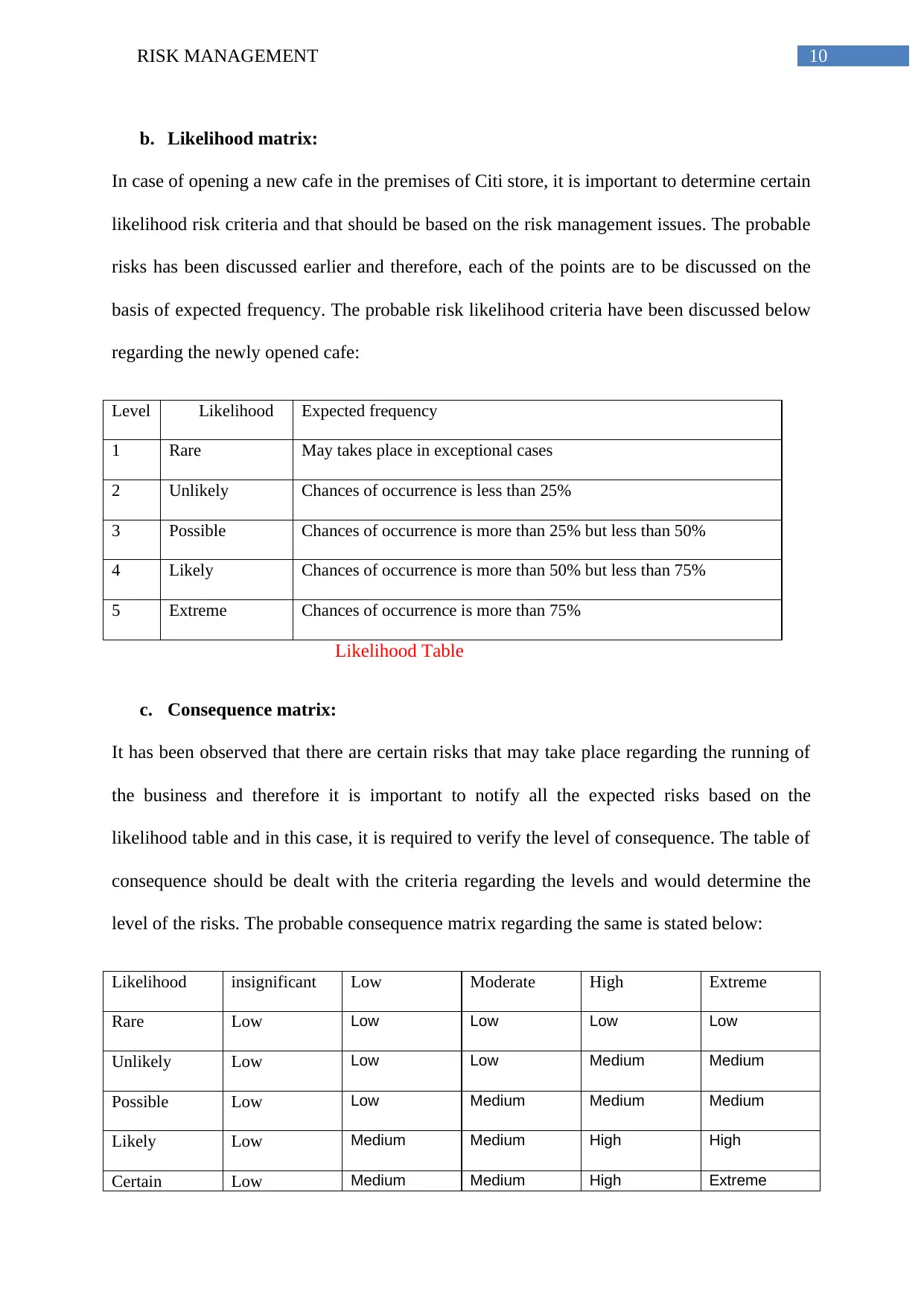
10RISK MANAGEMENT
b. Likelihood matrix:
In case of opening a new cafe in the premises of Citi store, it is important to determine certain
likelihood risk criteria and that should be based on the risk management issues. The probable
risks has been discussed earlier and therefore, each of the points are to be discussed on the
basis of expected frequency. The probable risk likelihood criteria have been discussed below
regarding the newly opened cafe:
Level Likelihood Expected frequency
1 Rare May takes place in exceptional cases
2 Unlikely Chances of occurrence is less than 25%
3 Possible Chances of occurrence is more than 25% but less than 50%
4 Likely Chances of occurrence is more than 50% but less than 75%
5 Extreme Chances of occurrence is more than 75%
Likelihood Table
c. Consequence matrix:
It has been observed that there are certain risks that may take place regarding the running of
the business and therefore it is important to notify all the expected risks based on the
likelihood table and in this case, it is required to verify the level of consequence. The table of
consequence should be dealt with the criteria regarding the levels and would determine the
level of the risks. The probable consequence matrix regarding the same is stated below:
Likelihood insignificant Low Moderate High Extreme
Rare Low Low Low Low Low
Unlikely Low Low Low Medium Medium
Possible Low Low Medium Medium Medium
Likely Low Medium Medium High High
Certain Low Medium Medium High Extreme
b. Likelihood matrix:
In case of opening a new cafe in the premises of Citi store, it is important to determine certain
likelihood risk criteria and that should be based on the risk management issues. The probable
risks has been discussed earlier and therefore, each of the points are to be discussed on the
basis of expected frequency. The probable risk likelihood criteria have been discussed below
regarding the newly opened cafe:
Level Likelihood Expected frequency
1 Rare May takes place in exceptional cases
2 Unlikely Chances of occurrence is less than 25%
3 Possible Chances of occurrence is more than 25% but less than 50%
4 Likely Chances of occurrence is more than 50% but less than 75%
5 Extreme Chances of occurrence is more than 75%
Likelihood Table
c. Consequence matrix:
It has been observed that there are certain risks that may take place regarding the running of
the business and therefore it is important to notify all the expected risks based on the
likelihood table and in this case, it is required to verify the level of consequence. The table of
consequence should be dealt with the criteria regarding the levels and would determine the
level of the risks. The probable consequence matrix regarding the same is stated below:
Likelihood insignificant Low Moderate High Extreme
Rare Low Low Low Low Low
Unlikely Low Low Low Medium Medium
Possible Low Low Medium Medium Medium
Likely Low Medium Medium High High
Certain Low Medium Medium High Extreme
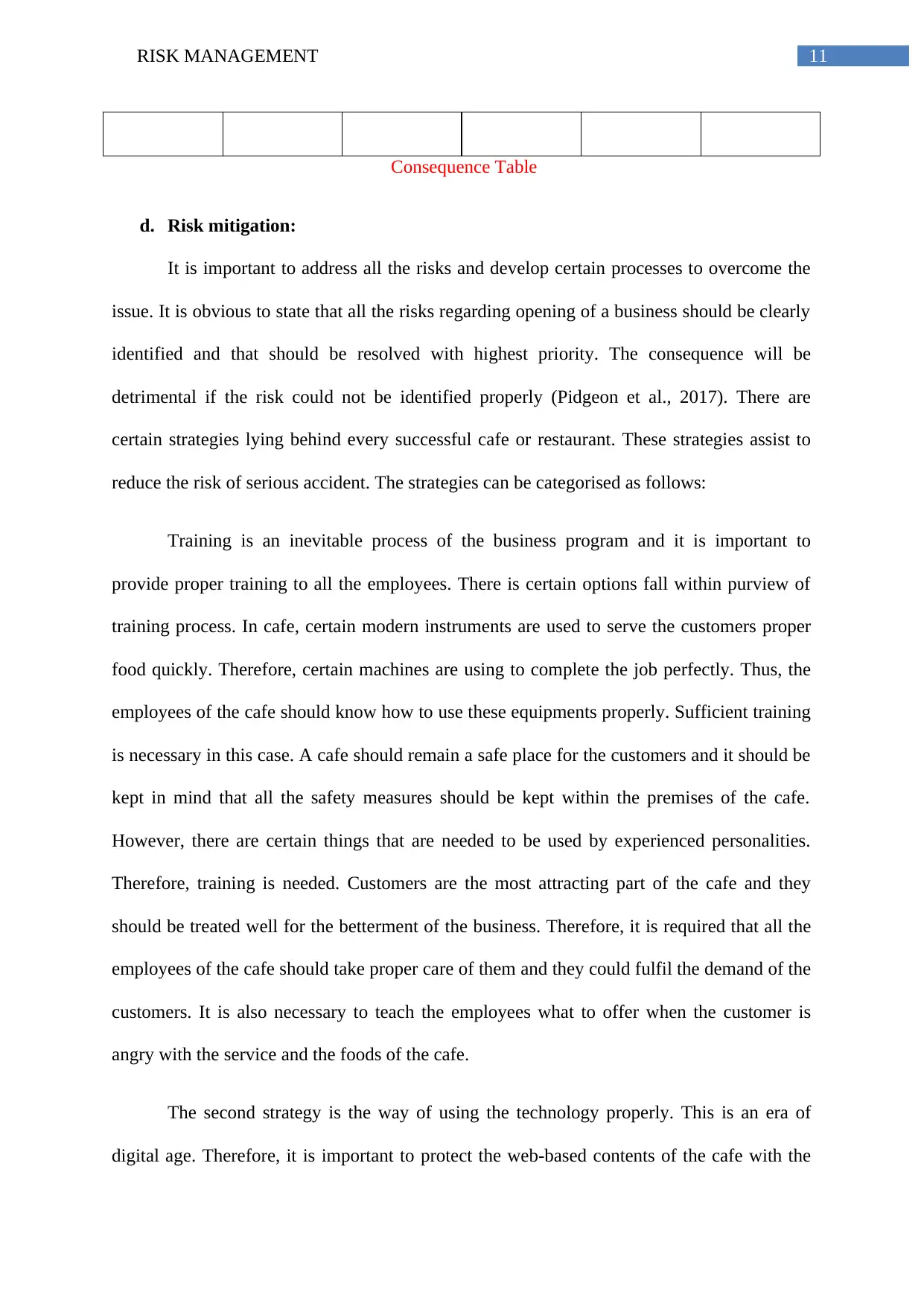
11RISK MANAGEMENT
Consequence Table
d. Risk mitigation:
It is important to address all the risks and develop certain processes to overcome the
issue. It is obvious to state that all the risks regarding opening of a business should be clearly
identified and that should be resolved with highest priority. The consequence will be
detrimental if the risk could not be identified properly (Pidgeon et al., 2017). There are
certain strategies lying behind every successful cafe or restaurant. These strategies assist to
reduce the risk of serious accident. The strategies can be categorised as follows:
Training is an inevitable process of the business program and it is important to
provide proper training to all the employees. There is certain options fall within purview of
training process. In cafe, certain modern instruments are used to serve the customers proper
food quickly. Therefore, certain machines are using to complete the job perfectly. Thus, the
employees of the cafe should know how to use these equipments properly. Sufficient training
is necessary in this case. A cafe should remain a safe place for the customers and it should be
kept in mind that all the safety measures should be kept within the premises of the cafe.
However, there are certain things that are needed to be used by experienced personalities.
Therefore, training is needed. Customers are the most attracting part of the cafe and they
should be treated well for the betterment of the business. Therefore, it is required that all the
employees of the cafe should take proper care of them and they could fulfil the demand of the
customers. It is also necessary to teach the employees what to offer when the customer is
angry with the service and the foods of the cafe.
The second strategy is the way of using the technology properly. This is an era of
digital age. Therefore, it is important to protect the web-based contents of the cafe with the
Consequence Table
d. Risk mitigation:
It is important to address all the risks and develop certain processes to overcome the
issue. It is obvious to state that all the risks regarding opening of a business should be clearly
identified and that should be resolved with highest priority. The consequence will be
detrimental if the risk could not be identified properly (Pidgeon et al., 2017). There are
certain strategies lying behind every successful cafe or restaurant. These strategies assist to
reduce the risk of serious accident. The strategies can be categorised as follows:
Training is an inevitable process of the business program and it is important to
provide proper training to all the employees. There is certain options fall within purview of
training process. In cafe, certain modern instruments are used to serve the customers proper
food quickly. Therefore, certain machines are using to complete the job perfectly. Thus, the
employees of the cafe should know how to use these equipments properly. Sufficient training
is necessary in this case. A cafe should remain a safe place for the customers and it should be
kept in mind that all the safety measures should be kept within the premises of the cafe.
However, there are certain things that are needed to be used by experienced personalities.
Therefore, training is needed. Customers are the most attracting part of the cafe and they
should be treated well for the betterment of the business. Therefore, it is required that all the
employees of the cafe should take proper care of them and they could fulfil the demand of the
customers. It is also necessary to teach the employees what to offer when the customer is
angry with the service and the foods of the cafe.
The second strategy is the way of using the technology properly. This is an era of
digital age. Therefore, it is important to protect the web-based contents of the cafe with the
⊘ This is a preview!⊘
Do you want full access?
Subscribe today to unlock all pages.

Trusted by 1+ million students worldwide
1 out of 28
Related Documents
Your All-in-One AI-Powered Toolkit for Academic Success.
+13062052269
info@desklib.com
Available 24*7 on WhatsApp / Email
![[object Object]](/_next/static/media/star-bottom.7253800d.svg)
Unlock your academic potential
Copyright © 2020–2025 A2Z Services. All Rights Reserved. Developed and managed by ZUCOL.





